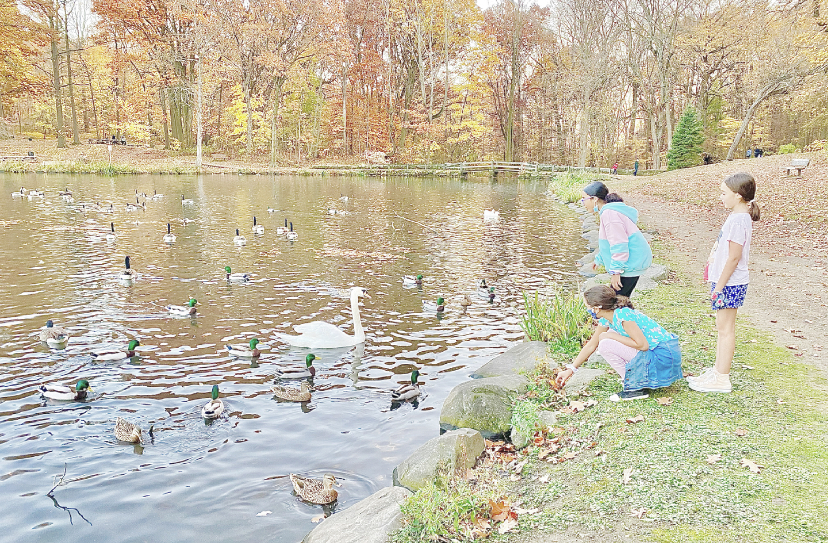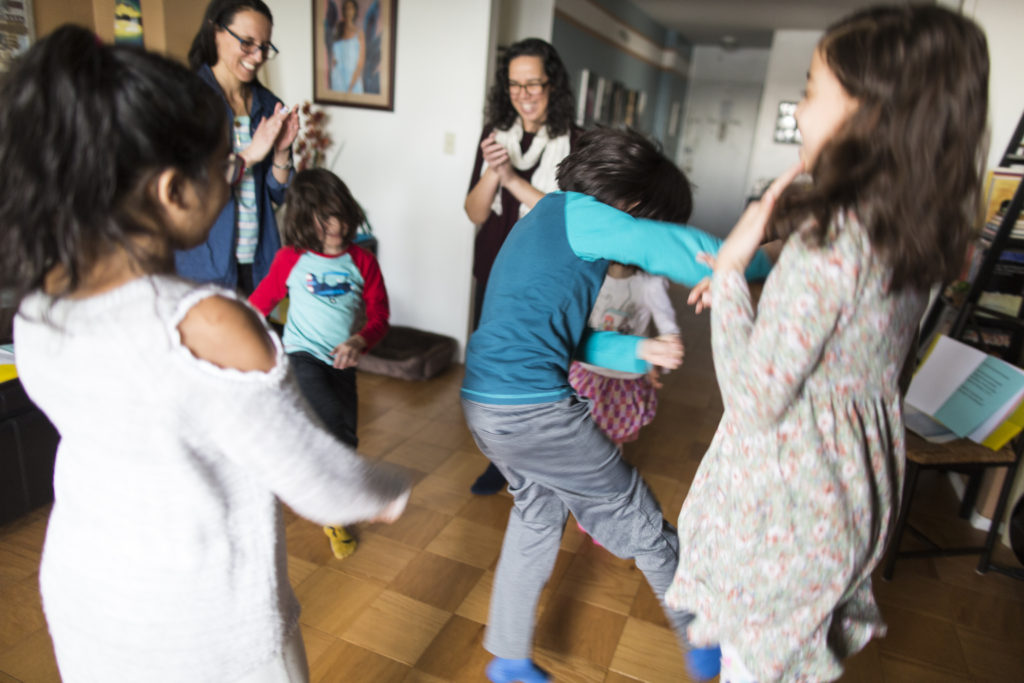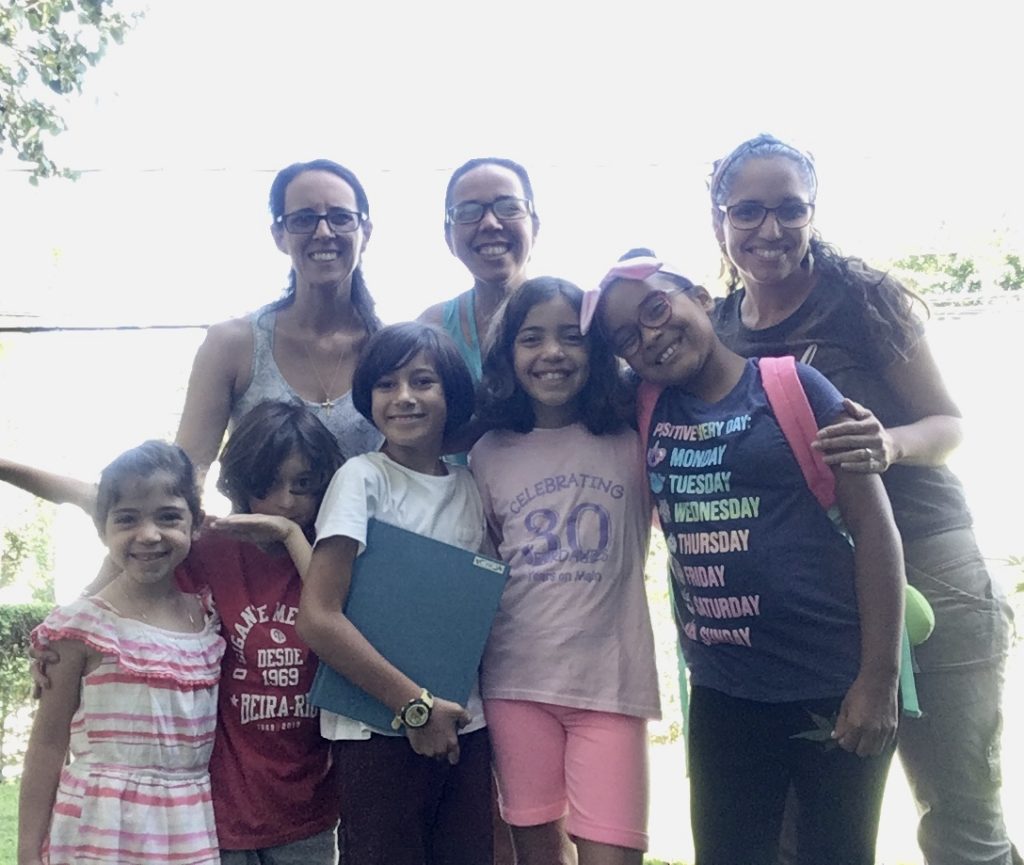Homeschooling an Only Child
Part 2: Group Interaction

“Solitary education is
the one great danger for an only child.”
The Parent’s Review (Volume 12, 1901)
Only Child Challenges
So what are the challenges of homeschooling an only child?
For starters, it’s just you and your child. All…day…long. That’s it. For those with multiple kids, that might sound peaceful, but let me burst your bubble and say it’s not all cupcakes and rainbows. I know sibling rivalry and bickering is annoying and distracting. Yet, despite the arguing, when it comes to homeschooling, there’s also a positive peer pressure that happens among brothers and sisters. For the most part, siblings enjoy playing with one another. They get to work on projects together, piggyback on each other’s narrations, act out a Shakespeare play together, explore nature and share each other’s discoveries. In essence, they get to share life together every day.
The other issue is what a friend of mine calls relational intensity. It describes a constant desire on the child’s part to want to be with their parent. “Mommy, can you play with me?” “Mommy, can you paint with me?” “Mommy, can you read with me?” “Mommy, come hear me play a new song!” “Mommy… Mommy… Mommy….” Beside mother, I become friend, playmate, and even sibling (where instead of the constant bickering between siblings, it’s constant bickering with me).
So does this all mean that our one student is doomed when it comes to homeschooling? Or that it’s impossible? Absolutely not. CM’s principles meet the needs of an only child as well.
The Education of an Only Child
2 fabulous articles I highly recommend for further reading in educating only children are “The Lessons of an Only Child” by Antonella Greco and “The Education of an Only Child” by Mrs. Clement Parsons.
“The Education of an Only Child” was an article printed in The Parents Review* in 1901 and edited by Miss Mason. Yet, so much of what is said concerning educating an only child is still relevant today, like not being an overprotective mom or not allowing bad habits to form at home. But for this post, I’ll focus on Parsons’ stress on group interactions and what it looks like in our homeschool.
(Please Note: I share examples from our homeschool as an encouragement and to inspire new ideas for anyone in need of them. This is not an exhaustive list and there are other ways to provide group interactions for your single student.)
1. The Vital Importance of Group Interaction:
“Solitary education is the one great danger for an only child. It accentuates his disabilities and blocks their remedies.”
“But schools of any kind only represent half a child's education, often less than half. What the isolated child specially lacks is the home companionship of children. Having them now and again to tea is not enough. To educate one another, children must be together from the rising of the sun even unto the going down of the same—the programme to be recommenced next day…but character can only grow in society; and, at the present time, more even than ever before, it is character that is the pearl of great price, the lever of the world. Therefore, I would urge upon every parent of an only child to let him be as much with his cousins and other contemporaries as possible. Bit by bit, in these wholesomer conditions, he casts those tendencies to priggishness and over-fastidiousness, which infect often the finer-fibred among only sons.”
If you’re anything like me, quotes like these are both encouraging and discouraging at the same time. To say “solitary education is the one great danger for an only child” when you only have one child is scary. What can you do when you only have one?!
That’s when group interactions come in. As mentioned above, “character can only grow in society.” It’s in the time spent with other children that an only child learns to share, to lead, to follow, to play fairly, and to work cooperatively in ways that can never really be done at home.
When my daughter was younger, I tried to teach her the concept of sharing at home. I would pretend to care that she wasn’t sharing a toy with me, but it just wasn’t as effective as when she actually had to share with another child.
That’s just a small example of how solitary education “accentuates his disabilities and blocks their remedies.” The remedies needed for “social” disabilities is found in interacting with others their age.
Join Groups
Joining co-ops, extracurricular activities or informal groups that meet up weekly at the park help tremendously. I get that it’s hard to find CM co-ops but if you come across a co-op with similar values or approach, it might be worth looking into. In addition, one benefit of having an only child is that there’s a little more wiggle room in terms of budgeting for a paid co-op or extracurricular activity.
Create Your Own Groups
What if there are no groups around or there aren’t any groups you’re interested in joining? Then start your own!
That was one of my very first lessons in homeschooling. I wanted my daughter to be in specific groups, like an art group or a book club, but there weren’t any so in time, I created my own.
It may sound intimidating to start your own groups, but as you pray for wisdom and discernment, you also pray for provision and creativity.
God knows the desires of your heart
and
He loves your child more than you do.
He will always provide what they need.
I can’t tell you how many times God has provided an artist who I could work with for an art club or a facility to meet up at for free. Or when He brought me a group of homeschooling friends who wanted to read children’s literature together so I could finally have a book club. He even provided Nature Clubs for us to participate in and when a mom stepped down from managing one of them, I stepped up to that role so my daughter would keep having opportunities to be with other children on a weekly basis exploring nature together.
If it’s in your heart to stay true to a CM philosophy, then you can have an informal group with other CM moms like I did. Although our children differ in ages, we chose subjects to study together once a week that weren’t as age-specific such as:
- Picture Study
- Composer Study
- Singing
- Dance
- Swedish Drill (fitness)
- Art
- Handicrafts
- Nature Study
- Geography
- Literature (like reading a great read aloud or doing a Shakespeare play together).
These weren’t all done in one day. We alternated some subjects by terms.

If you’re the only CM mom in your local area, you can still take a similar approach because most homeschooling parents are interested in Nature Study, Literature, or the arts, even if they don’t follow Miss Mason’s philosophy. You can follow the method informally so it can have a more inclusive atmosphere and provide the fellowship your child needs.
Special Celebrations
Another idea for group gatherings is to do special homeschool celebrations.
I’m an Event Coordinator for one of the local chapters of a NYS homeschool support group called LEAH (Loving Education at Home) and have been blessed to work alongside fellow LEAH moms in providing such opportunities. We also partner up with other non-LEAH homeschooling mamas and our local library. Here are some of our events that usually end with tons of play-time afterwards (another plus for an only child):
- Meet & Greet Park Day
- Apple Picking
- Family Potluck
- Thanksgiving Potluck
- Reading Masquerade (Dress up as book character from a current book read and do a book presentation)
- Night of Recitation (can be done in the day as well)
- National Pancake Day @IHOP
- Math Challenge
- Spelling Bee
- Science Fair
- Education Fair
- Cultural Fair
- Field Day
- Recognition Night (Award Ceremony at the end of the school year where parents create their own award and celebrate their children. One year for my daughter, my award was titled the “The Pickwick Club” since my daughter loved the Little Women series and really connected with Jo’s character. I gave her a quill pen and ink set as a gift to celebrate her growth as a writer.)
We also do trips together to museums, theaters, nature preserves, etc…
Another special thing I do with my “only” at home are book celebrations. After we finish a book for school, we put together a themed “party” and invite friends to participate. Sometimes we dress up as the characters, create activities based on the book, and/or cook foods from the story. In the past, we’ve done Narnia, Little House, and quite a few other titles/series.
Organize Weekly Meet-Ups
Leading your own content-specific groups or events sound too nerve-wracking for you? Then just plan weekly meet ups to a park or a preserve to do a nature walk together. You can choose a park, day and time that others know will always be in place. Share with other homeschooling friends, local groups and social media. As the word spreads, more and more people will come with their kiddos.
Keep Balance
When you have an “only”, it’s easy to get sucked into participating in every group possible, like I did. You’re desperate for fellowship and don’t have as many financial or childcare constraints that parents of multiple children often have. With that freedom, it’s tempting to be part of everything offered for your child’s sake. My first year homeschooling, I was out of the house so much, we barely did any schooling at home. There was an imbalance.
To keep the balance, it’s so important that you really know your child and understand who they are as a person. Think about what their desires are and what are the needs you help fulfill as their mother. Also, remember what the vision God has given to you for your child and for your homeschool.
I had to look at what was really dear to my daughter’s heart, what was pivotal in our homeschool and what activities I just thought were really cool but not really necessary.
On one end, I had to balance the fact that my daughter is a SERIOUS extrovert. But I also had to keep in mind that we needed time to do school work at home too. As a result, I started being more protective of our mornings and carefully choosing what afternoon activities we could participate in so they wouldn’t interfere with our morning lessons or keep us out of our home all day.
Just recently, being quarantined caused me to do some self-reflection. I really enjoyed being home without running from activity to activity. I asked the Lord what should I let go of in our busy schedule once quarantine is over.
My daughter LIVES for dance and gymnastics so that couldn’t go anywhere. Thankfully, dance is on the weekends, which doesn’t affect our school day. Gymnastics is only once a week for a local homeschooling class I put together. So that’s not a problem either. Music, however, involved me traveling twice a week for 3 classes (in addition to a co-op class and several afternoon meet-ups).
Being homebound, my daughter was meeting with her music teachers virtually. What was an eye opener for me was how much she was practicing on her own, creating original pieces and independently learning other songs not assigned by her teachers. It got me thinking that maybe it was time for her to learn independently online since she has a strong music foundation.
So we had a good discussion as a family, weighing all the pros and cons. Since my daughter is already 10, we let her decide and after a couple of weeks, she decided to continue learning piano online, allowing us to be home more (and save us a ton of money). We did, however, set up with our CM group to have recitals at the end of our terms next year, that way she’s still able to celebrate and perform among peers.
Spend Time with Family & Other Non-homeschooling Friends
Group gatherings don’t all have to be with other homeschooling friends. There are other opportunities like spending time with cousins and friends from the neighborhood, church, extracurricular activities and other walks of life. The point is that even though our child won’t be with other children “from the rising of the sun even unto the going down of the same”, we can provide ongoing opportunities for companionship.
Teen Years
A huge benefit of homeschooling is that most of our kids can hang out with children of various ages easily because they’re not used to being separated by ages or grades. My daughter can effortlessly spend time with a one year old as she would another 10 year old as she would a teenager. It’s pretty amazing to watch.
Regardless, the teen years can get more challenging. There may come a time your teen doesn’t want to attend activities where there are mostly little kids. Or there are less teens being homeschooled so your child is in the minority. This is when parents have to be even more proactive with group gatherings.
The suggestions I gave above still apply but the content and audience change. Church youth groups and extracurricular activities supply wonderful opportunities for teens to connect. For school, you can try finding teen groups that are gathering in your local homeschool support groups. If there aren’t any, like I said before, create your own.
Don’t worry if there aren’t enough teen homeschoolers in your community. It’s not about quantity. It’s about quality so if you have a solid group of 3-5 teens, that’s all you need.
Now, I know firsthand how much work it takes to organize something. However, the big shift here that differs from before is that you now have a teen on your hands. Your teen, along with the help of others, can work independently in creating communities they want to be part of. All you would have to do is provide opportunities, support and guidance.
This past year, our local LEAH chapter came across this very same need for a teen group. We shared ideas with each other but I also reached out to a fellow homeschool mom from another chapter who has 3 teens. She shared the following ideas that worked so well for their teen group, that she didn’t do a thing except be a support, facilitate co-ops, and find spaces for them to meet up at.
IDEAS FOR TEEN GATHERINGS
Start off a Teens-Only Meet-Up
This can be whatever your teens want it to be and they can meet up however many times they want. It can be monthly or weekly. Whatever works for them.
Vision Meeting for the Teens
Parents can set up a Vision Meeting for the teens. Have them over for brunch or pizza in the evening. Ask them what they want to see or do for the year so there’s ownership. It’s not another homeschool class mom wants them to attend. Instead, it’s a gathering of value for them. It can be their safe place where they make life-long friends.
Meet-Up Activities
If they are monthly meet-ups, some ideas could be:
- Paintball/air soft
- House gathering/“Hangs”
- Movies
- Escape Room
- Meet at a Museum
Hot Topics Discussion
It can include relevant topics chosen by parents based on observations or student interests: Current Events, men are from Mars & women are from Venus, DC vs Marvel, etc… It’s a great intro to get them into talking. (If it’s a debate, let them know beforehand of the topic and they have to prepare in advance to defend their stance.)
Teen Co-ops
Classes can be alternated by terms (12 week sessions)
Some class ideas can be:
- Art
- Handicrafts
- Citizenship
- Civics
- Book Club (can include literature from a historical period)
- Creative Writing
- Shakespeare
- Poetry
- Drama
Drama Ideas:
1) Book/Discussion/Play
Term 1-Read a play
Terms 2 & 3- Discussion/Production (rehearsals, costumes, set, sound, created bulletins, etc…)
2) Create an Original Play
Term 1- Write a play
Terms 2 & 3- Discussion/Production (rehearsals, costumes, set, sound, created bulletins, etc…)
Science Day Workshop–
-full-blown dissections
-3 hour workshop
-Resources: Specimens and Dissection Kits bought online
Yearbooks:
Created by the teens. Some ideas:
Kids submit pictures, stories, poetry, artwork.
Parents submit pictures from events throughout the year.
Profile page for graduates or profile page for teens (maybe vision for their graduating year: i.e:Vision for 2020)
Newsletter Team:
Kids work on it with editor-in-chief (parent or student)
Possible Content:
- Upcoming events
- Current Events
- Movie Reviews
- Jokes
- Art
- Poetry
These are all just ideas to show that there are many group gatherings you can provide and tailor for your child as well as their local homeschooling community
2. Be Selective of Your Tribe
“Utilise other people's children. I think that every only child would be the better for having a little succession of children to stay during half, at least, of all his holidays—and for himself going to stay in the households of other children. In that way he gets a good working substitute for what he lacks under his own roof-tree, and this is the true 'Education of an Only Child'—where it needs to be different, I mean, and peculiar. The only child's general education is naturally the same thing as the many-brothered child's.”
“You will soon discover, by-the-by, which are going to be the best children (I mean the most rightly educative children) for your only child to associate with… I should say that the constructive, busy-fingered children are the best companions for the only child; they will give him most of what he gets least of in his home.”
Okay. So most of us are not going to send our child to stay at a friend’s house for days, as suggested above. However, the idea is to have your child spend numerous hours with peers, especially those with siblings. Spending time in people’s homes, your child can learn how another family functions: how an older sibling has compassion on a younger one, how the children help with chores while mom cares for a baby, how they live and love together.
But a mother MUST be selective of who she chooses her child to spend hours on end with. It’s okay to hang out with other struggling families who you can be a light to. That’s what God calls us to do. However, who you chose to “live life” with and spend hours with has to be more prayerfully and carefully selected. These other children will inevitably influence your child and vice versa so they must be children who will have a positive impact on them. Being around other kids who enjoy creating, using their imagination and playing outdoors help protect your child from the modern pressures of electronics. There’s no such thing as perfection but attributes such as kindness, compassion, dedication, and obedience go a long way. You want your child to experience authentic friendships and healthy family dynamics so when they are older, they know what to look for in choosing their own friends. In providing such friendships, we must be protective, wise and listening to the Holy Spirit’s guidance.
Mama Needs Friends Too
A mother, too, needs such friends, women who breathe life into her. Don’t feel pressured to be in an uncomfortable “relationship” because your child really likes a particular friend. It makes such a difference when you find a kindred spirit in another mom AND your children get along. If you and another mom don’t really “click” but your kids do, you are not forced to continue this relationship out of desperation to provide companionship for your child.
The 2 homeschooling families we spend the most time with both have multiple children. We spend innumerable hours together, both in our CM informal co-op as well as play dates throughout the week. In their homes, my daughter has witnessed chores being completed with joy, compassion for younger siblings, and obedience to their parents. I, too, have been inspired to require more responsibility from my daughter after having seen the loving expectations of these family households where they work together in keeping their home.
These friendships did not happen by chance. I asked the Lord for new friends to walk this journey with as we are the only homeschoolers in our circle. They are my answered prayer in COUNTLESS ways, including introducing me to Charlotte Mason. They make us better. And that’s what God does. He calls us to homeschool, even when people think we’re doing our only child a disservice by not “socializing” them, and then He provides ALL we need, like friends who become family.
In Part 3, I’ll focus on some helpful tips on using Charlotte Mason methods in our home with only one student.
*The Parents Review was a monthly magazine of home-training and culture that was sent to parents and teachers of Charlotte Mason’s schools between the approximate years of 1890-1920.





Pingback: Homeschooling an Only Child- Part 1: The Shame of “an Only” |
Pingback: Homeschooling an Only Child- Part 3: CM Education in the Home |